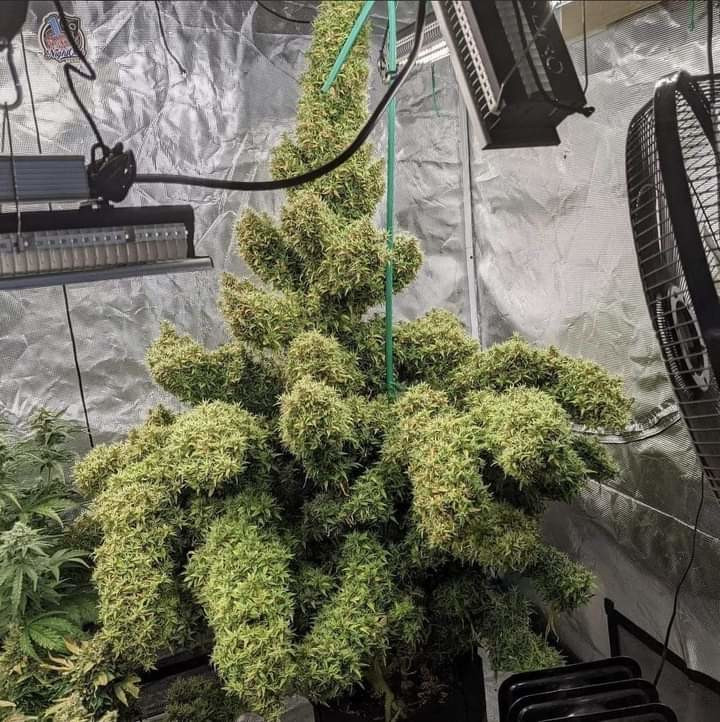Are you a new indoor weed grower? Almost all indoor cannabis growers want to get bigger yields for less money, time and effort. I will cover some easy ways to increase yields of your indoor cannabis crop at the final harvest, no matter which seeds you’re growing!
These top growing tips and tactics will help to increase your cannabis yields with any seed strain. However, the seeds (genetics) you start with will have the biggest influence on your final grow room yields. For weed cultivators who want to start with high-yielding seed genetics just check the THC content listed in our strain charts. Our charts include THC content, yields and growing notes specific to each strain with exactly what it needs.
Once you have learned the basics of weed seed growing you are ready to handle the following tactics in order to get the most yields from your indoor growing space.
Table of Contents
- Increase Light Intensity
- Add CO2
- Control Temperature and Humidity
- Plant Training (free way to grow more buds)
- Provide Correct Amount of Nutrients (less is more)
- Harvest Plants Properly (don’t harvest early!)
1. Increase light intensity to Increase Yields
When growing weed inside, more light will typically give you larger yields. A lot of Dagga Seeds growers ask me how to increase the number, size and density of their flowering plants so they can attain larger yields. The first answer I always give to our growers is that the most effective way to increase yields is to increase Light INTENSITY.
Let’s learn how to improve your indoor grow lights so you get the highest light intensity available to your plants.
Light is the main factor that will influence yields since it is the food for your plants in a sense. Through photosynthesis, your weed plant converts light energy into food for the buds.
More Light = Larger Plants = Fatter Buds = Bigger Yields
After you’ve germinated your Dagga seeds, the light will be one of the most important things you need to monitor and change. During the early growing stages of weed plants, if they don’t get enough light, they will ‘stretch’ up toward the light. By keeping the light close to the top of the canopy, it will encourage the plants not to stretch and fall over.
This stretching is typically avoided because these seedings usually fall over and break during flowering. Taller plants are harder to give light coverage to all the bud sites and will tend to get lower yields in most indoor setups. In order to grow large and dense marijuana buds indoors, you need powerful grow lights.
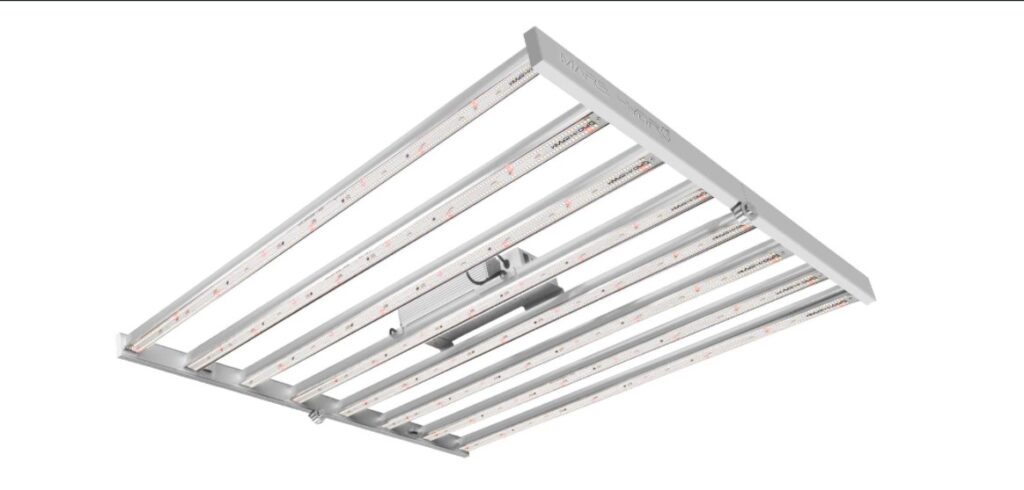
How much light is too much for Cannabis?
Fortunately, most of you are unlikely to provide too much light to your weed plants – cannabis plants can absorb a tremendous amount of light naturally! It evolved outdoors in the wild and grows best when exposed to direct sunlight. So as long as the cannabis grower keeps their lights the right distance above the top of the plants, they’re unlikely to receive more light than they can handle.
Fluorescent grow lights
Fluorescent grow lights and especially CFL’s are very weak so they can be kept as close to your weed plants as possible while not touching and burning the leaves. These lights are best suited for cloning and sprouting only.
LED grow lights
When using high-power LED grow lights, keep them around 12″ away, and with some quantum board led’s usually 18 inches + away for the best growth. The height above the canopy needed for LED lights will be different from model to model, so follow the manufacturer’s specifications on how close to keep LEDs to your canopy. Modern Quantum Board LED grow lights are very intense, and It’s very possible to light-burn your plants with Quantum LEDs.
HPS/MH grow lights
HPS/MH grow lights typically should be kept 12 to 24 inches away, though the actual distance needed depends on the wattage of the bulb. These bulbs generate a significant amount of heat and sometimes need to be managed with the use of a vented light fixture. With all types of grow lights, it’s important to have some type of exhaust system in place to mitigate heat stress and help bring fresh air with CO2 to the plants. Also by using a vented grow light fixture you can get the light closer to the canopy before stressing the plant with heat.
If we know that light is like food for a weed plant, maximizing the light is like force-feeding your plants until they hurt themselves trying to finish their food. Plants given too many lumens can experience light burn even if the temperatures are cool enough. Some cannabis strains are more vulnerable to intense light burn than others. In other words, there is a maximum amount of light that your plants can use but this can be extended slightly with the adding of CO2.
2. CO2 to increase yields of cannabis plants
When you are maxed out on the light that your plants can absorb, you still have a way for them to absorb some more by adding CO2 to increase your yields. Increasing the CO2 levels during flowering can give them an extra boost when you want them to absorb more of the light you have to offer. As we already said light is like the food for the plant, so think of using CO2 like undoing the button on your pants to make room for more food.
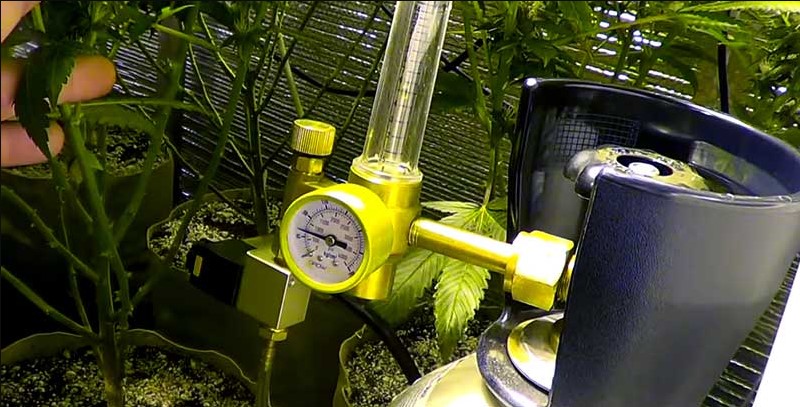
The way supplementing with additional CO2 works is it increases the amount of light your plant can absorb at very high lumen levels. With smaller grow lights like fluorescent or even a 400W HPS bloom light, it is very unlikely that your light is so bright as to bring your plants to the point where they are limited by CO2 levels. Adding extra CO2 when you aren’t using powerful lights is almost always a waste of money and effort. For most weed plants, giving them a source of fresh air will deliver all the CO2 they need for flowering. But if you are using powerful lights and you know that you are maxed out on light levels, raising the CO2 levels in the grow room can help cannabis and all plants absorb more light and turn it into energy for flowering.
Just keep this in mind, it takes a significant amount of light for your weed plants to hit this light saturation point. So unless you’re using a 1000W grow light (or high-power LEDs), your plants are already using all the light they’re getting. Adding CO2 to the grow room does not guarantee an increased yield. CO2 only allows your weed plant to utilize more lumens when exposed to very high-intensity light levels. If your weed plants have not maxed out on light, adding more CO2 will not help the grower to increase yields.
A safety tip about using CO2 – In order for CO2 gas to be effective, you will have to seal off the grow room and add in enough CO2 to dramatically increase the CO2 PPM levels in the air. CO2 is a dangerous gas to humans and animals at these levels, so be careful and air out any CO2 before entering the grow room to tend your plants!
The next tip will also allow your plants to utilize more light by manipulating them into producing more bud sites that are exposed to the light and for them to get even amounts of light.
3. Control Temperature (and humidity) to Increase Yields
When setting up your grow room, consider 85 degrees F (29 degrees C) as the maximum temperature the plants will get exposed to. A proper environment is critical to the health of your weed plants, as well as final yields and potency. When your temperature is too low or too high the buds won’t fatten up no matter what else you do. Also to a lesser extent humidity can do the same, if you have wildly high humidity levels your buds won’t grow or worst yet they will develop bud rot.
4. Plant training so all colas receive more even light coverage
The basic principle behind weed plant training is that larger, wider plants with many evenly spaced flowering sites produce larger yields. With this method, many colas are spaced evenly and trained to be around the same height.
Manipulating your plants is a free way to increase your yields. Well, sort of, with training comes an extra growing time in the vegetative stage so more electricity is needed. Although with training there is no expensive equipment to purchase like CO2 tanks or extra nutrients.
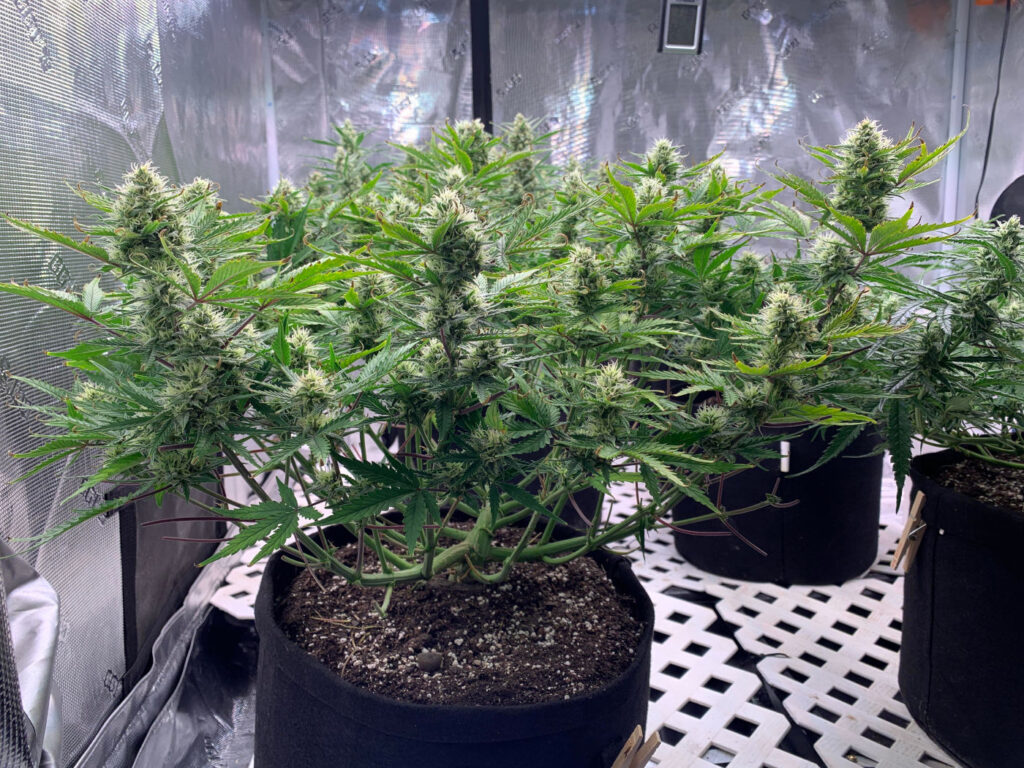
The most popular and easiest method of manipulating your weed plant is often referred to as “LST” in the weed cultivating world, which is short for “Low-Stress Training. This is a method that doesn’t involve actually cutting your plant. The idea behind Low-Stress Training is to encourage(force) your plant to grow wide and flat, as opposed to tall, usually by employing bending.
Notice how the plant in the above picture is short when viewed from the side, but has a lot of bud surface area exposed to the light. All those leaves and flowers are getting tons of energy from your grow light. This wide and flat weed plant shape allows the cannabis plant to better use your existing grow setup since more buds are closer to the light source, which means more massive buds when it comes time to harvest.
Any Low-Stress Training should begin when the plant is very young, as this flat shape is much harder to accomplish once the plant has developed into a tall plant with a tall main cola.
Learn how to do Low-Stress Training here:
https://daggaseeds.com/lst-low-stress-training/
Another popular and easy-to-learn weed plant training method that increases yields is known as “Super cropping.”
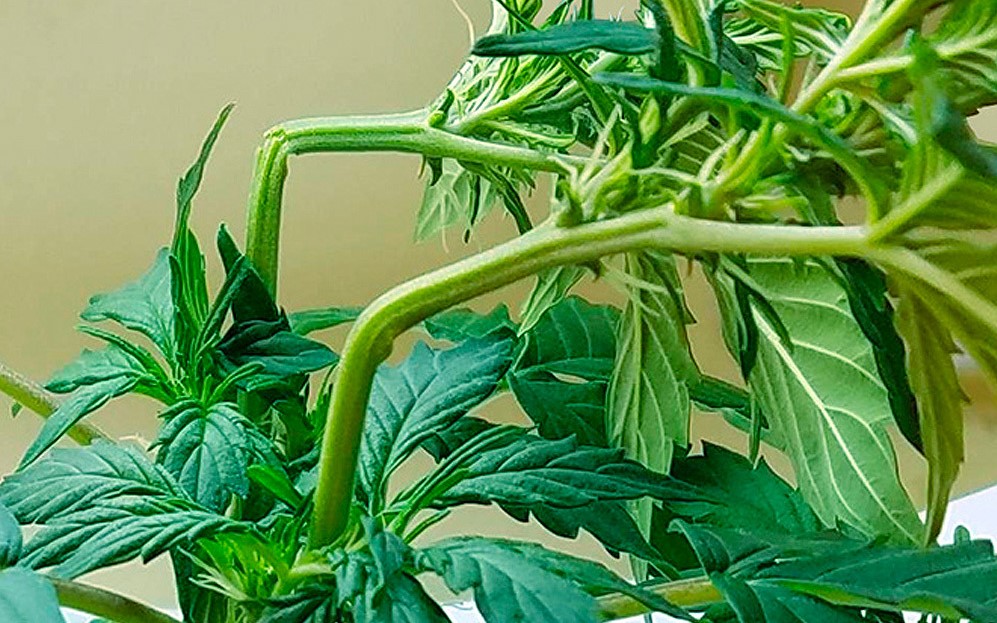
Super cropping is the weed training method of bending your plant so that individual stems lay flat and form a “knuckle” underneath where they were bent.
Super cropping can also be done with other plant training methods or by itself. Whenever you find that a cola growing taller than the rest, but are unable to use low-stress bending to pull down the run-away cola, you can use super cropping to force it to bend.

Fiming and Topping plants to increase yields
As far as High-stress methods that require you to actually cut the plant, you have two main choices. One is to ‘top’ the plant the other method is to ‘FIM’ the plant.
With both high-stress weed plant training techniques, you remove some of the growth from the tip of the main cola of your young weed plant. This causes the plant to shift focus to other colas rather than just the main one. Utilizing this training method can help create a sea of buds.
Learn more about Topping & FIMing young weed plants here
Main-lining to increase yields
A very popular weed training method being used right now to increase yields that utilizes topping and really seems to simplify the weed training process for a lot of cultivators is known as main-lining. Dagga Seeds recommends against using this weed training technique until you already have been successful with other training methods first.
Defoliation can damage or even kill your weed plants if done improperly. This method is an important one to learn for any serious grower but master the basics before ever trying defoliation.
5.) Cannabis Nutrients to Increase Yields(and don’t overdo it!)
Your weed plant needs nutrients to thrive, no disputing that fact. But which nutrients should you feed them?
How many nutrients should you give your weed plants to grow their best?
Getting the correct kind and amount of weed plant nutrients and following a proper feeding schedule isn’t the only consideration when it comes to nutrients. Unfortunately, anxious growers tend to provide too high a level of nutrients to their weed plants. This happens most often when growers mix many different supplements and plant nutrients together, without knowing how much and what type at what stage to give.
If you want to be a master grower, it is important that you can recognize when your plants are showing signs that they’re being over-fertilized.
The easiest and most common sign that your plants are getting too much fertilizer is “nutrient burn.”
The first sign of nutrient burn is often yellowing at the tips of the cannabis plant leaves.
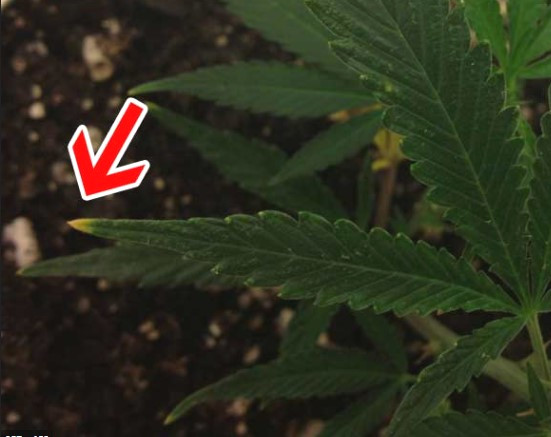
Even though as growers we refer to fertilizer as the “food” for your plants. When you think about it that way, it logically seems like giving more “food” would result in larger colas, but is that really true? As we read above in the section about light intensity, the real “food” for your weed plants is light. Light is the thing that your plant turns into energy through photosynthesis. This energy derived from light is what fuels vegetative and flowering growth.
Then what does the fertilizer do? Nutrients are like little helpers that help your weed plant carry out the process of photosynthesis and growth. They work in a similar way that vitamins help humans. While we humans require certain vitamins to live, you should never eat a whole bottle of multi-vitamins at once. In fact, if you did take the whole bottle you would take more than your body can absorb and get very ill. Fertilizers and supplements are important to healthy plant growth, but it’s important to realize that using too much fertilizer will cause more harm than good.
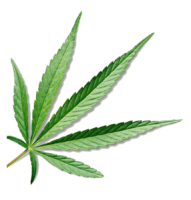
While most weed growers are trying to increase nutrient levels as high as possible, I get better results (yields) when I simply try to give the plant only the amount it can absorb.
Healthy marijuana plant leaves appear green and uniform. As long as your leaves resemble the picture, without signs of spots, dark green discoloration, curling or other issues, you have nothing to be concerned about!
Marijuana plants seem to thrive and give the best yields when nutrient levels are kept on the lower end of manufacturer-recommended dosages. I try to feed my plants enough nutrients to prevent growing deficiencies while still avoiding nutrient burn. I don’t increase nutrient levels unless I’m seeing signs that this particular weed plant is a heavy nutrient feeder and requires more. As you grow different strains you will learn that different plants often need very different levels of fertilizers and supplements.
As long as your weed plants don’t display signs of nutrient burn or deficiencies, you’re in the “zone” for optimum growth and yields
Super Soil to Increase Yields
When it comes to growing marijuana in soil, the best thing you can do is make your own super soil. Our super soil recipe is completely organic and will provide your weed plants with all the nutrients required throughout your whole grow. Using super soil to increase yields will leave you more time to focus on training your plant canopy.
Bottled Nutrients
For you growers who are going to be using bottled nutrients, I almost always recommend starting with only half (or even less) of the manufacturer’s suggested amount listed on the bottle. I typically raise my nutrient levels only when I notice that a specific plant is a heavy nutrient feeder. You will recognize a heavy feeder when you notice the bottom leaves are starting to turn yellow and die. Keep in mind this yellowing is normal in the last two weeks of flowering and you shouldn’t add any more nutrients in this late stage. Reducing nutrient levels is especially important to large bud production during the last 2-4 weeks before harvest time.

It’s natural for the plant to start eating its own leaves as the plant puts all energy into reproducing, and unfortunately, many weed growers ramp up nutrient levels late in the flowering stage to try and combat the yellowing or dying of leaves. Adding nutrients, especially nitrogen in the last two weeks will actually hurt your final yields.
If you are patient and keep your nutrient levels low and allow the water leaves to die away during those last couple of weeks, the buds seem to increase their size dramatically. This stopping of the feeding schedule and feeding the plant only clean pH adjusted water will also flush any residual nutrients from the buds. Lowering my overall nutrient feeding schedule and letting the water leaves die as harvest approaches improve my bud yields compared to when I feed my plants until harvest. Not only that but it also seems to improve the final aroma and flavour of the weed.
6.) Wait until the right time to harvest
For most weed seed strains we sell, there is about a 2-week window during which buds should be chopped. When chopping your plants too early it will hurt the potency and also the final yield. Be patient and wait until the proper “harvest window” to increase your yields (and potency). Your patience will pay off as buds can fatten as much as 30% larger in the last two weeks before the chop.
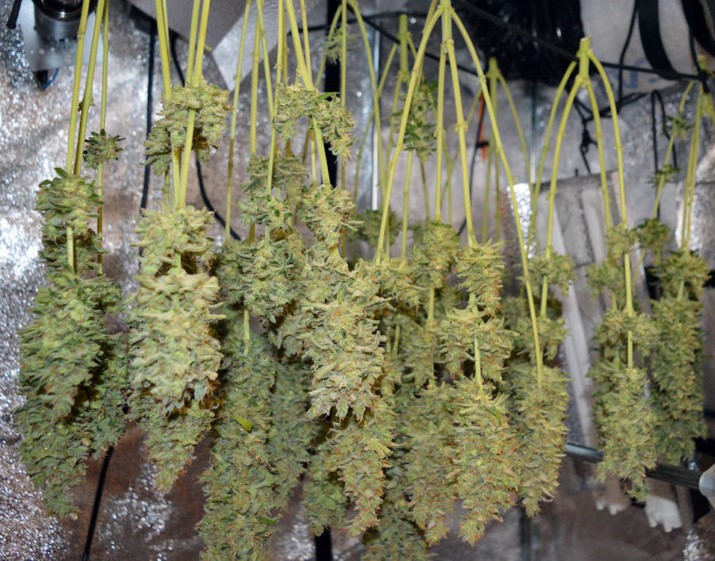
You can also extend the flowering cycle to get the exact effects you are looking for. Chopping your buds later will give the user a more relaxing buzz. Harvesting early will give more of a cerebral high but reduce yields.
And also make sure you properly cure your newly harvested marijuana buds every time…
https://daggaseeds.com/how-to-harvest-and-cure-your-cannabis-plants/
Bonus Tip For Soil Growers:
Give your plants some sugar in the form of Black Strap Molasses near the middle to end of the flowering cycle. This added sugar will help fatten your buds and also improve the final flavour. This works incredibly well in organic growing setups as it works symbiotically with the microorganisms in the soil.
There are tons of commercial bud-enhancing supplements that will help fatten up buds and improve flavour, but most of them are just an expensive version of molasses.
If you do grow organically and want to save money then just add a teaspoon per gallon of water in the mid to late stages of flowering.
Please Note: It is not recommended to use molasses in a hydroponic system.
Genetics is Key to Marijuana Potency and Yields
While our best tricks to increase yields listed above will help increase your yields with any marijuana seed strain, the genetics of your weed plant will play the biggest role in how large it grows, how big the buds will be, and ultimately your final yields.
The strains we are breeding now get much higher yields than any weed that was around even a decade ago. Through our crossbreeding and constant improvements in strain potency, yields, and ease of growth we are improving on old favourites.
Investing in one of our high-yielding strains can be the ultimate way to maximize the final yields, quality, potency and aroma of your buds.
Start With A High-Yielding Strain!

